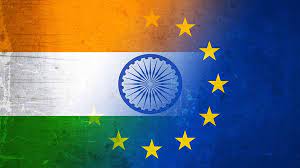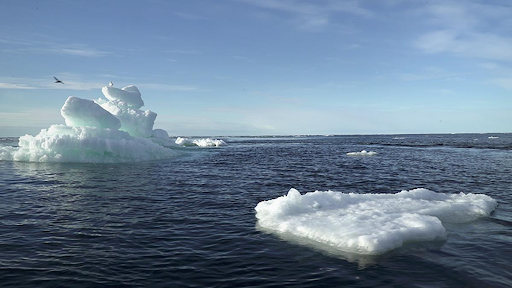Description

Copyright infringement is not intended
Context: Russia-China ‘no limit’ pact opens doors for India-EU convergence. India and the US are also working on a similar trade and technology council on the lines EU has now set up with India and has with Washington.
More about news:
- With the EU having a trade and technology council with US and now with India, it is only a matter of time that India and US will finally be able to close negotiations and set up a similar trade and technology council.
- This means that there will be political and strategic convergence between India, EU and US on economy, trade, and technology with direct impact on security and climate change.
About EU:
- The European Union (EU) is a political and economic union of 27 member states that are located primarily in Europe.
- The EU has developed an internal single market through a standardised system of laws that apply in all member states in those matters, and only those matters, where members have agreed to act as one.
- EU policies aim to ensure the free movement of people, goods, services and capital within the internal market; enact legislation in justice and home affairs; and maintain common policies on trade, agriculture, fisheries and regional development.
Overview of India EU relations
- India and the EU will be collaborating on green hydrogen and renewable energy technologies.
- It is only after the Chinese belligerence in the Indo-Pacific and the Russian invasion of Ukraine in Europe that the EU has started looking at India as a viable alternative for global supply chains and as a technology partner.
Political:
- Both take great pride in their democracies and both are under pressure from hard nosed authoritarian neighbours.
Economic:
- The EU is India’s first trading partner and the biggest foreign investor, with €67.7 billion worth of investments made in 2018, equal to 22% of total FDI inflows.
- Europe is also the biggest source of foreign investment in India – though many European firms operate from Mauritius or Singapore shell companies for tax reasons.
Climate Change:
- The EU is building on its ambitious target to render the continent carbon-emission neutral by 2050, through its new industrial strategy, the Green Deal.
Broad-based Trade and Investment Agreement (BTIA)
- India and the EU have been working on a Broad-based Trade and Investment Agreement (BTIA) since 2007.
- The EU's major demand is that India should lower its tariffs on automobiles, wines and spirits. India has demanded the lowering of the non-tariff barriers such as sanitary and phyto-sanitary barriers along with the strict technical barriers to trade.
- Trade-in services are the most contentious area in the BTIA negotiations.
- There are disagreements with regards to Intellectual property protection standards.
COVID-19 effects
- The EU work together in order to mitigate the economic and human effects of the COVID-19 pandemicand work towards ensuring an inclusive and sustainable socio-economic recovery.
- The EU’s approach and engagement look to foster a “rules-based international order, a level playing field, as well as an open and fair environment for trade and investment, reciprocity, the strengthening of resilience, tackling climate change and supporting connectivity with the EU.
- Free and open maritime supply routes in full compliance with international law remain crucial.
- On trade partnerships, the EU aim to conclude free trade agreements with Australia, Indonesia and New Zealand and take further steps towards the Comprehensive Agreement on Investment with China.
- The EU continue to explore deepening economic relations with India.
Security cooperation
- The EU will continue to develop partnerships in the areas of security and defence, including to address maritime security, malicious cyber activities, disinformation, emerging technologies, terrorism, and organised crime.
- On security cooperation, the Council build on its experience of protecting critical maritime routes in the Indian Ocean through maritime domain awareness.
- EU has taken the decision to extend the geographic scope of its CRIMARIO (Critical Maritime Routes) II activities from the Indian Ocean into South and Southeast Asia with a view to contribute to safer sea lanes of communication with the EU.
Export potential:
- India has an untapped export potentialof $39.9 billion in the EU and Western Europe.
- The top products with export potential include apparel, gems and jewellery, chemicals, machinery, automobile, pharmaceuticals and plastic.
- India benefits from tariff preferences under the EU’s Generalized System of Preferences (GSP)for several of these products.
- India is among the major beneficiaries of the EU’s GSP, with exports under the GSP valued at nearly $19.4 billion in 2019, accounting for nearly 37% of India’s merchandise exportsto the EU.
- However, there are several products where India has export potential in the EU, but these have “graduated” or are at the brink of “graduation” under EU GSP.
- Product graduation applies when average imports of a product from a beneficiary country exceed 5% of EU-GSP imports of the same productfrom all beneficiary countries over three years.
- India’s exports of products such as textiles, inorganic and organic chemicals, gems and jewellery, iron, steel and their articles, base metals and automotives are already out of the ambit of EU-GSP benefits.
https://epaper.thehindu.com/Home/ShareArticle?OrgId=GER9OCD04.1&imageview=0&utm_source=epaper&utm_medium=sharearticle













